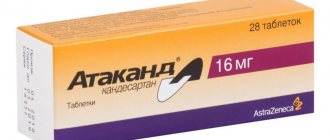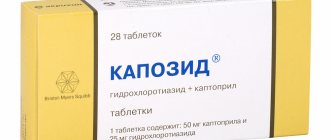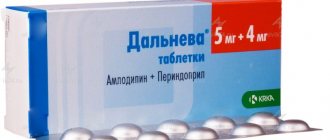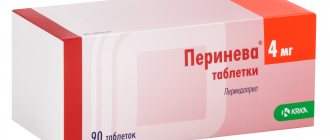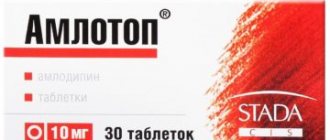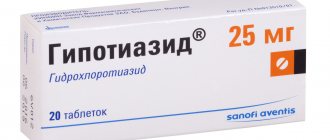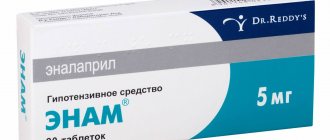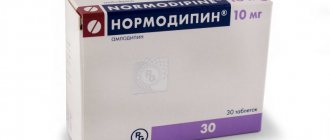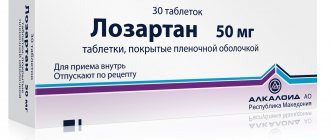pharmachologic effect
Angiotensin II is the main hormone of the RAAS, which plays an important role in the pathogenesis of arterial hypertension, heart failure and other cardiovascular diseases. The main physiological effects of angiotensin II are vasoconstriction, stimulation of aldosterone production, regulation of fluid and electrolyte status, and stimulation of cell growth. The effects are mediated by the interaction of angiotensin II with angiotensin type 1 receptors (AT1 receptors).
Candesartan is a selective antagonist of AT1 receptors of angiotensin II, does not inhibit ACE, which converts angiotensin I into angiotensin II, destroying bradykinin, does not lead to the accumulation of bradykinin or substance P. As a result of blocking the AT1 receptors of angiotensin II, a dose-dependent increase in the content of renin and angiotensin I occurs , angiotensin II and a decrease in the concentration of aldosterone in the blood plasma.
When comparing candesartan with ACE inhibitors, the development of cough was less common in patients receiving candesartan.
Candesartan does not bind to the receptors of other hormones and does not block ion channels involved in the regulation of the functions of the cardiovascular system.
Pharmacodynamics: how it affects blood pressure
Ordiss blood pressure tablets have an antihypertensive effect by suppressing the production of the hormone angiotensin II, which contributes to the development of hypertension, CHF, other pathologies, blood vessels and the heart.
Acting as an angiotensin antagonist, the drug Ordiss reduces blood pressure, has a vasodilatory effect, prevents the accumulation of bradycardin, helps to increase renin levels in the blood, while simultaneously reducing aldosterone levels.
The undoubted advantage of the drug for pressure Ordiss is the fact that it does not have a suppressive effect on ion channels and other hormonal receptors responsible for the normal state and functions of the cardiovascular system.
Ordiss belongs to the group of angiotensin 2 receptor antagonists
Pharmacokinetics
- Suction and distribution
When candesartan is absorbed from the gastrointestinal tract, cilexitil quickly turns into the active substance, candesartan, through ether hydrolysis, binds strongly to AT1 receptors and slowly dissociates, and has no agonist properties. The absolute bioavailability of candesartan after oral administration is about 40%. The relative bioavailability of the tablet form compared to the oral solution is approximately 34%. Thus, the calculated absolute bioavailability of the tablet form of the drug is 14%. Food intake does not have a significant effect on AUC, i.e. food does not significantly affect the bioavailability of the drug.
Cmax in blood plasma is achieved 3-4 hours after taking the drug in tablet form. As the dose increases within the recommended limits, the concentration of candesartan increases linearly.
The binding of candesartan to plasma proteins is more than 99%. Plasma Vd of candesartan is 0.1 l/kg.
The pharmacokinetic parameters of candesartan do not depend on the gender of the patient.
- Metabolism and excretion
Candesartan is mainly excreted unchanged from the body by the kidneys and intestines and is only slightly metabolized in the liver. T1/2 is approximately 9 hours. Cumulation of candesartan in the body is not observed.
The total clearance of candesartan is about 0.37 ml/min/kg, while the renal clearance is about 0.19 ml/min/kg. Renal excretion of candesartan is carried out by glomerular filtration and active tubular secretion.
When radiolabeled candesartan is administered orally, approximately 26% of the administered amount is excreted in the kidneys as candesartan and 7% as an inactive metabolite, whereas 56% of the administered amount is found in the feces as candesartan and 10% as an inactive metabolite.
- Pharmacokinetics in special clinical situations
In patients over 65 years of age, the Cmax and AUC of candesartan increase by 50% and 80%, respectively, compared with younger patients. However, the hypotensive effect and the incidence of side effects when using candesartan do not depend on the age of the patients.
In patients with mild and moderate renal impairment, Cmax and AUC of candesartan increased by 50% and 70%, respectively, while T1/2 did not change compared to patients with normal renal function.
In patients with severe renal impairment and/or those on hemodialysis, the Cmax and AUC of candesartan increased by 50% and 110%, respectively, and T1/2 increased by 2 times.
In patients with mild to moderate hepatic impairment, the AUC of candesartan increased by 23%.
Pharmacokinetics of the drug
Once in the gastrointestinal tract, the active components of the drug are transformed into candesartan. The bioavailability of Ordiss is about 34%.
The medication lowers blood pressure 3–4 hours after taking the tablets, when the maximum level of concentration of its active components in the human body is reached.
The half-life of the drug takes on average about 9 hours. Ordiss is excreted through the renal apparatus along with urine (25%) and with feces through the intestines (26%). Another 10% of the drug is released in the form of inactive metabolites.
Directions for use and doses
Orally, regardless of food intake, 1 time/day.
- Arterial hypertension
The recommended starting dose of Ordiss is 8 mg 1 time/day. For patients who require further reduction in blood pressure, it is recommended to increase the dose to 16 mg 1 time / day. For patients who failed to sufficiently reduce blood pressure after 4 weeks of taking Ordiss at a dose of 16 mg/day, it is recommended to increase the dose to 32 mg 1 time/day. The maximum antihypertensive effect is achieved within 4 weeks from the start of treatment.
If therapy with Ordiss does not reduce blood pressure to the optimal level, it is recommended to change the treatment regimen.
Therapy should be adjusted according to blood pressure levels.
In elderly patients there is no need to adjust the initial dose of the drug.
In patients with mild or moderate renal impairment (creatinine clearance 30-80 ml/min/1.73 m2 body surface area), including patients on hemodialysis, the initial dose of the drug is 4 mg/day (1/2 tablet of 8 mg). The dose should be titrated depending on the therapeutic effect of the drug.
Clinical experience with the use of the drug in patients with severe renal impairment (creatinine clearance <30 ml/min/1.73 m2 body surface area) or end-stage renal failure (creatinine clearance <15 ml/min) is limited (see section "Special instructions").
In patients with mild to moderate liver dysfunction, it is recommended to start treatment with a daily dose of 4 mg 1 time / day (1/2 tablet of 8 mg). It is possible to increase the dose if necessary. Ordiss is contraindicated in patients with severe liver dysfunction and/or cholestasis (see section “Contraindications”).
Concomitant therapy: the use of Ordiss in combination with thiazide-type diuretics (for example, hydrochlorothiazide) may enhance the antihypertensive effect of Ordiss.
Hypovolemia: the recommended initial dose of Ordiss is 4 mg (1/2 tablet of 8 mg) 1 time/day.
- Chronic heart failure (CHF)
The recommended initial dose of Ordiss is 4 mg 1 time / day (1/2 tablet 8 mg). The dose is increased to 32 mg 1 time / day or to the maximum tolerated dose by doubling it at intervals of at least 2 weeks.
Elderly patients and patients with impaired renal function, liver function or hypovolemia do not require a change in the initial dose of the drug.
The safety and effectiveness of Ordiss in children and adolescents under 18 years of age have not been established (see section “Contraindications”).
Concomitant therapy: the drug Ordiss can be prescribed together with other drugs used in the treatment of chronic heart failure, for example, with ACE inhibitors, beta-blockers, diuretics and cardiac glycosides (see sections “Special instructions”, “Pharmacological action”).
Indications of Ordiss tablets
Medical experts recommend drinking Ordiss for high blood pressure in patients who have the following clinical indications for the use of this drug:
- Chronic heart failure;
- Arterial hypertension;
- Impaired systolic functions of the left cardiac ventricle;
- Hypertonic disease.
Ordiss for pressure can be used as an independent medication, as a substitute for ACE inhibitors (for patients suffering from intolerance to the latter), and for carrying out a complex therapeutic course as one of its components.
The drug is used for hypertension and chronic heart failure
Side effect
The incidence of side effects is classified according to WHO recommendations: very often (≥10%), often (≥1%, but <10%); uncommon (≥0.1%, but <1%); rare (≥0.01%, but <0.1%), very rare (<0/01%, including isolated reports).
From the hematopoietic system: very rarely - leukopenia, neutropepia, thrombocytopenia, agranulocytosis.
From the immune system: very rarely - skin rash, itching, urticaria, angioedema.
From the nervous system: often - dizziness, headache, weakness.
From the respiratory system: often - respiratory infections, pharyngitis, rhinitis.
From the digestive system: very rarely - nausea.
From the liver and biliary tract: very rarely - increased activity of liver transaminases, impaired liver function, hepatitis.
From the cardiovascular system: often - a pronounced decrease in blood pressure.
From the musculoskeletal system and connective tissue: very rarely - back pain, arthralgia, myalgia.
From the urinary system: often - impaired renal function.
Laboratory indicators: very rarely - hyperkalemia, hyponatremia, increased creatinine concentration, hyperuricemia, decreased hemoglobin.
Other: very rarely - exacerbation of gout, “flushes” of blood to the face.
Manifestations of side effects
Patients who take Ordiss for high blood pressure should be aware of the following side effects that may be caused by this drug:
- Nausea;
- Excessive decrease in blood pressure;
- Painful sensations localized in the back area;
- Tides;
- Hyperkalemia;
- Attacks of headaches;
- Hyponatremia;
- Asthenic syndrome, weakness, lethargy, malaise, decreased performance;
- Impaired liver function;
- Attacks of dizziness;
- Hyperuricemia;
- Agranulocytosis;
- Thrombocytopenia (decreased blood clotting rates);
- Skin itching:
- Impaired renal activity;
- Allergic rashes on the skin like urticaria;
- Swelling of angioedema nature;
- Leukopenia;
- Anemia;
- Neutropenia;
- Nasal congestion.
In patients with diagnosed gout, the medicine may cause an exacerbation of this disease. In rare cases, during treatment with Ordiss tablets, pathologies such as hepatitis, myalgia, pharyngitis, arthralgia, and infectious processes of a respiratory nature develop.
Any undesirable reactions or deterioration of well-being during the therapeutic course is a reason to contact a specialist in order to adjust the dosage of the medication or select a substitute drug.
Headache and dizziness - possible side effects
Contraindications
- Hypersensitivity to candesartan and other components of the drug.
- Severe liver dysfunction and/or cholestasis.
- Pregnancy.
- Breastfeeding period.
- Children and teenagers up to 18 years of age.
- Lactose intolerance, lactase deficiency, glucose-galactose malabsorption syndrome.
- Concomitant use with aliskiren (direct renin inhibitor) in patients with diabetes mellitus and/or renal impairment (GFR less than 60 ml/min/1.73 m2 body surface area).
With caution: hemodynamically significant stenosis of the aortic and mitral valves, cerebrovascular diseases, coronary artery disease, hypertrophic obstructive cardiomyopathy (HOCM), condition after kidney transplantation, bilateral renal artery stenosis or stenosis of the artery of a single kidney, primary hyperaldosteronism, severe renal failure (CC<30 ml /min), hemodialysis, hyperkalemia; patients with reduced blood volume, general anesthesia and surgical interventions (risk of developing arterial hypotension due to blockade of the RAAS).
Contraindications of the drug
Taking Ordiss with high blood pressure is strictly prohibited by doctors for patients who have the following clinical contraindications:
- Cholestasis;
- Lactose intolerance;
- Hypotonic disease (low blood pressure);
- Severe liver pathologies;
- Lack of lactase in the patient’s body;
- Individual intolerance and hypersensitivity to the ingredients contained in the tablets;
- Hyperkalemia;
- Cerebrovascular diseases;
- Ischemic disease;
- Stenosis of the aortic or mitral valve of the heart;
- Hypertrophic cardiomyopathy of an obstructive nature;
- Dehydration of the body;
- Hyperaldosteronism;
- Previously undergone surgical interventions for a kidney transplant;
- Lack of blood volume circulating in the body;
- Severe renal dysfunction.
Tablets are not prescribed to patients undergoing hemodialysis, as well as during planned surgical interventions using general anesthesia, due to the increased risk of developing severe arterial hypotension, up to a hypotensive crisis.
Use during pregnancy and breastfeeding
The drug Ordiss is contraindicated for use during pregnancy due to the fact that candesartan has a direct effect on the RAAS, can cause fetal development disorders or have a negative effect on the newborn, including death.
If pregnancy is detected during treatment with Ordiss, the drug must be discontinued immediately. When planning pregnancy, it is necessary to transfer the patient to adequate therapy approved for use during pregnancy.
Newborns whose mothers took Ordiss during pregnancy should be under medical supervision due to the likelihood of developing arterial hypotension.
It is not known whether candesartan is excreted in breast milk. Ordiss should not be used during breastfeeding. If it is necessary to use the drug during lactation, breastfeeding should be stopped.
Pregnancy and breastfeeding period
For expectant mothers, the use of Ordiss tablets is strictly contraindicated, since this drug, penetrating the placental barriers, negatively affects the baby, provokes various developmental defects and can even lead to the death of the baby.
If the fact of pregnancy is detected directly during the therapeutic course, you must immediately stop taking the pills and undergo a medical examination.
Children born to patients taking this medicine are under strict medical supervision for a certain period of time, which is due to the increased risk of developing hypotension in the newborn, which occurs in an extremely severe form.
Treatment with Ordiss is contraindicated for women planning to conceive in the near future.
The drug is not recommended during lactation due to insufficient reliable information about the ability of its active ingredients to pass into breast milk. If the patient needs therapy with Ordiss tablets, it is recommended that the baby be switched to artificial feeding.
The medicine is contraindicated for pregnant and lactating women
Childhood
The drug is not used for the treatment of young patients under the age of majority, which is due to insufficient information about the effect of the drug Ordiss on the immature children's body.
Elderly age
Elderly people can use Ordiss for high blood pressure in standard dosages, without additional correction, provided there are no clinical contraindications.
special instructions
Concomitant use of ACE inhibitors, ARB II or aliskiren increases the risk of developing arterial hypotension, hyperkalemia and renal dysfunction (including acute renal failure). Double blockade of the RAAS when using ACE inhibitors, ARB II or aliskiren is not recommended (see section “Drug Interactions”).
If double blockade of the RAAS is considered absolutely necessary, then treatment should be carried out only under the supervision of a physician and with regular monitoring of renal function, electrolyte levels and blood pressure. ACE inhibitors and ARB II should not be used simultaneously in patients with diabetic nephropathy.
Release form, composition
Ordiss is available in the form of tablets of 8, 16 and 32 mg. The color of the tablets is pink, the shape is capsule-shaped.
The active substance of the drug is candesartan cilexetil.
Some excipients include:
- Magnesium stearate.
- Carmellose calcium.
- Iron oxide (red dye).
- Lactose monohydrate.
- Starch in pregelatinized form.
- Poloxamer.
- Povidone.
The main therapeutic effect of sartans is to block receptors for type 1 angiotensin 2. Angiotensin II is the most important hormonal pressure regulator; it causes vasoconstriction, stimulates the release of aldosterone, and affects the level of sodium and water in the vascular bed. This group of drugs also includes Ordiss, which contains a biphenyl tetrazole derivative, candesartan.
The price of the drug is affordable for most consumers, depends on the dosage and averages from 400 rubles per pack of 30 tablets.
The main active ingredient is candesartan cilexetil. This drug is a highly selective angiotensin receptor antagonist, thus completely eliminating all physiological effects of the latter.
Several clinical studies have proven the organoprotective effect of sartans, which consists of reducing microalbuminuria in patients with diabetes and reducing the risk of developing atrial fibrillation. The drug has cardioprotective properties against myocardial hypertrophy.
Candesartan also has a metabolic effect - it reduces the level of uric acid when used simultaneously with diuretics, increases the sensitivity of peripheral tissues to glucose and improves cell nutrition.
The tablets also contain excipients: starch, povidone, microcellulose, lactose, iron oxide, magnesium stearate. All of them have auxiliary properties and are approved for use in the pharmaceutical industry.
Properties
The positive properties of the drug include high bioavailability - up to 40%, which does not depend on food intake. Binds well to blood proteins, preferably albumin.
The antihypertensive effect is dose-dependent, develops gradually and allows you to maintain an optimal blood pressure level throughout the day.
In addition to the main component, Ordiss N contains a second active ingredient - hydrochlorothiazide. It is a thiazide diuretic, the effect of which is to enhance the excretion of sodium, water, and chlorine. Thus, the volume of circulating fluid in the vessels decreases and blood pressure decreases. This potentiates the hypotensive effect of candesartan.
Renal dysfunction
With the use of the drug Ordiss, as with the use of other drugs that inhibit the RAAS, in some cases it is possible to develop impaired renal function.
When using the drug Ordiss in patients with arterial hypertension and severe renal failure (creatinine clearance less than 30 ml/min), it is recommended to regularly monitor the potassium content and creatinine concentration in the blood serum. Clinical experience with the drug in patients with end-stage renal failure (creatinine clearance less than 15 ml/min) is limited. When using the drug Ordiss® in such patients, it is necessary to select the dose of the drug Ordiss under the control of blood pressure.
In patients with CHF, renal function should be periodically monitored, especially in patients over 75 years of age and patients with impaired renal function. When increasing the dose, it is also recommended to monitor the potassium content and creatinine concentration in the blood serum.
There is no data on the use of the drug Ordiss for CHF with a creatinine concentration of more than 265 µmol/l (more than 3 mg/ml).
- Hemodialysis
During hemodialysis, blood pressure may be especially sensitive to AT1 receptor blockade as a result of a decrease in blood volume and activation of the RAAS. Therefore, patients on hemodialysis need to monitor blood pressure and individually select the dose of Ordiss in accordance with blood pressure levels.
- Concomitant use with ACE inhibitors for CHF
When used simultaneously with ACE inhibitors, the risk of side effects increases, especially renal dysfunction and hyperkalemia. The clinical condition of patients and relevant laboratory parameters should be monitored.
- Renal artery stenosis
Drugs that affect the RAAS (eg, ACE inhibitors) may lead to increased serum urea and creatinine concentrations in patients with bilateral renal artery stenosis or solitary renal artery stenosis. A similar effect can be expected with the use of angiotensin II receptor antagonists.
- Kidney transplant
There is no experience with the use of Ordiss in patients who have recently undergone kidney transplantation.
- Arterial hypotension
In patients with CHF, arterial hypotension may develop when using the drug Ordiss. It is also possible to develop arterial hypotension in patients with BCC deficiency, for example, when using diuretics in high doses. In this case, before using the drug Ordiss®, it is necessary to correct the blood volume.
- General anesthesia and/or surgery
In patients receiving angiotensin II antagonists, hypotension may develop during general anesthesia and during surgery as a result of blockade of the RAAS. In rare cases, arterial hypotension may be severe, requiring IV fluids and/or vasopressors.
Stenosis of the aortic and/or mitral valves, HOCM.
When using the drug Ordiss in patients with HOCM or hemodynamically significant stenosis of the aortic or mitral valves, caution should be exercised.
- Primary hyperaldosteronism
Patients with primary hyperaldosteronism are usually resistant to therapy with antihypertensive drugs that affect the RAAS, so the use of Ordiss in this group of patients is not recommended.
- Hyperkalemia
Concomitant use of Ordiss with potassium-sparing diuretics, potassium preparations or salt substitutes containing potassium, or other drugs that can increase serum potassium levels (for example, heparin) may lead to the development of hyperkalemia in patients with arterial hypertension.
Hyperkalemia can also develop in patients with CHF taking the drug Ordiss. During therapy with Ordiss® in patients with CHF, it is recommended to periodically monitor the potassium level in the blood serum, especially with the simultaneous use of ACE inhibitors and potassium-sparing diuretics (spironolactone, triamterene, amiloride).
- Are common
Patients whose vascular tone and renal function are predominantly dependent on the activity of the RAAS (for example, patients with severe chronic heart failure, kidney disease, including renal artery stenosis) are especially sensitive to drugs acting on the RAAS. The use of such drugs is accompanied in these patients by severe arterial hypotension, azotemia, oliguria and, less commonly, acute renal failure. The possibility of developing the listed effects cannot be excluded when using angiotensin II receptor antagonists. A sharp decrease in blood pressure in patients with ischemic cardiopathy, cerebrovascular diseases of ischemic origin when using any antihypertensive drugs can lead to the development of myocardial infarction or stroke.
What to replace for hypertension
On the shelves of pharmacy chains you can also find the following substitutes, analogues of Ordiss:
- Candesartan;
- Atakand;
- Xarten;
- Angiakand;
- Candecor;
- Hyposart.
The drugs listed above are not complete analogues of Ordiss tablets, therefore, in order to avoid adverse consequences, it is strongly recommended to entrust the selection of a suitable substitute to a qualified medical specialist!
The blood pressure drug Ordiss is a very effective remedy that improves the condition of the cardiovascular system as a whole, especially when used in a course. Tablets should only be prescribed by the attending physician on an individual basis due to certain nuances associated with restrictions on the use of the drug and determining the optimal dose.
Overdose
Symptoms: analysis of the pharmacological properties of the drug suggests that the main manifestation of an overdose may be a clinically pronounced decrease in blood pressure and dizziness. Isolated cases of drug overdose (up to 672 mg of candesartan) have been described, resulting in the recovery of patients without serious consequences.
Treatment: with the development of a clinically significant decrease in blood pressure, it is necessary to carry out symptomatic treatment and monitor the patient’s condition. Place the patient on his back and elevate his legs. If necessary, the volume of blood volume should be increased, for example, by intravenous administration of 0.9% sodium chloride solution. If necessary, sympathomimetic agents can be used. Removal of candesartan by hemodialysis is ineffective.
Drug overdose
Taking Ordiss tablets in excessively large quantities can lead to severe dizziness and an excessive decrease in blood pressure, up to a hypotensive crisis.
Medical experts note that in most cases the drug is well tolerated and even an overdose rarely leads to dangerous consequences.
However, if there are signs of overdose, careful monitoring of the victim's blood pressure is necessary. To prevent a hypotensive crisis, it is recommended to place the patient with his legs elevated and ensure absolute rest. In severe cases, it may be necessary to administer a sodium chloride solution intravenously, carrying out symptomatic drug treatment using medications prescribed by medical specialists on an individual basis.
Drug interactions
Dual blockade of the RAAS using angiotensin II receptor antagonists (ARA II), ACE inhibitors or aliskiren (direct renin inhibitor) may be accompanied by an increased risk of arterial hypotension, syncope, hyperkalemia and renal dysfunction (including acute renal failure) compared with monotherapy. Regular monitoring of blood pressure, renal function and electrolyte levels in the blood is necessary in patients taking candesartan and other drugs that affect the RAAS.
Candesartan should not be used concomitantly with aliskiren or aliskiren-containing drugs in patients with diabetes mellitus and/or impaired renal function (GFR less than 60 ml/min/1.73 m2 body surface area).
With simultaneous use of ACE inhibitors and dipeptidyl peptidase type 4 inhibitors (for example, vildagliptin), the risk of developing angioedema may be increased.
With simultaneous use of candesartan with hydrochlorothiazide, warfarin, digoxin, oral contraceptives (ethinyl estradiol/levonorgestrel), glibenclamide, nifedipine and enalapril, no clinically significant drug interactions were identified.
Candesartan is metabolized in the liver to a small extent with the participation of the CYP2C9 isoenzyme. Interaction studies have not revealed the effect of candesartan on the CYP2C9 and CYP3A4 isoenzymes; the effect on other isoenzymes of the cytochrome P450 system has not been studied.
The simultaneous use of candesartan with other antihypertensive drugs enhances the antihypertensive effect.
Experience with other drugs acting on the RAAS shows that concomitant therapy with potassium-sparing diuretics, potassium preparations, salt substitutes containing potassium, and other drugs that increase potassium levels in the blood serum (for example, heparin) can lead to the development of hyperkalemia.
With the simultaneous use of lithium preparations and ACE inhibitors, a reversible increase in the concentration of lithium in the blood serum and the development of toxic reactions occur. Similar reactions can also occur when using angiotensin II receptor antagonists, and therefore it is recommended to monitor the lithium content in the blood serum.
Concomitant use with NSAIDs, including selective COX-2 inhibitors, acetylsalicylic acid (more than 3 g/day) and non-selective NSAIDs, may reduce the antihypertensive effect of candesartan and may also lead to an increased risk of renal dysfunction, incl. to the development of acute renal failure and an increase in potassium levels in the blood serum. The combination of these drugs should be used with caution, especially in elderly patients.
Brief information about the medicine
The blood pressure medicine Ordiss is an angiotensin 2 receptor antagonist.
Release form
The medication is available in tablet form, convenient for home use. Each tablet has a line on it, designed for comfortable dosing of the drug, and the amount of the main active ingredient is indicated. The medicine is sold in pharmacies in packs containing 3 blisters of 10 capsules each.
Composition of tablets
The main active component of the tablets is candesartan in dosages of 16 mg or 32 mg.
Additional substances included in blood pressure tablets include magnesium stearate, starch, povidone, microcrystalline cellulose, calcium carmellose, lactose monohydrate.
Packaging of Ordiss tablets
pharmachologic effect
The drug has pronounced antihypertensive therapeutic properties.
Manufacturer
The manufacturer of Ordiss tablets is the Israeli pharmaceutical company.
Storage conditions and periods
The maximum permissible shelf life of tablets is 2 years. The drug should be stored in a dry place at a temperature not exceeding +25°C.
Conditions for dispensing from a pharmacy
It is possible to purchase a medicine in pharmacy chains only after presenting an appropriate prescription from a medical specialist.
Price
The cost of the drug is affected by the dose of its main active component. The approximate price of Ordiss tablets varies from 300 rubles to 520 rubles.
Indications and contraindications
These tablets are widely known as an effective blood pressure medication. It is advisable to prescribe them to persons with a constant blood pressure level above 140/90 mm Hg. and with frequent hypertensive crises for their prevention.
It is necessary to carefully evaluate the benefits and risks when prescribing sartans to people with severe heart defects, obstructive cardiomyopathy, cerebrovascular accident, severe liver and kidney failure, and renal artery stenosis. The drug should also be discontinued before surgery using general anesthesia due to the high risk of hypotension.
Use in minor children, pregnant and breastfeeding women is strictly prohibited. Contraindicated for use in case of individual intolerance to one of the components or lactose intolerance.
Description of the mechanism of action, pharmacodynamics and pharmacokinetics
If the pressure increases, the speed of blood flow increases. This is harmful to blood vessels. Damaged vessels increase the risk of developing serious cerebral (cerebral infarction) and heart diseases.
The endogenous body substance angiotensin II plays an important role in the tension of muscles around blood vessels. Angiotensin II blockers prevent the action of this substance and thereby reduce it in vascular smooth muscle. Antagonists help blood vessels relax and dilate. Blood flows better and blood pressure decreases. Angiotensin type 1 receptor blockers promote urinary sodium excretion. It also helps lower blood pressure. In combination with other medications, the drugs work more effectively, so they are often used together with diuretics or beta-blockers.
The drug does not cause a dry cough, which occurs very often when using ACE inhibitors. Also, the drug does not cause angioedema as often as other drugs. However, the medication is not recommended for use if there is a history of this disorder.
The maximum therapeutic effect of the drug is achieved within 3-6 weeks. If the patient does not notice any noticeable changes, treatment should not be stopped. To accurately check the effectiveness of the drug, it is necessary to regularly measure blood pressure.
It is important to take candesartan every day. Only then can this agent optimally protect the heart and blood vessels
Main indications for use of the drug:
Possible analogs and substitutes
Angiakand (from 159.20 rubles), Candesartan-SZ (from 160.00 rubles), Xarten (from 206.40 rubles), Giposart (from 212.50 rubles), Candesartan (from 248.00 rubles)… Show all analogues of the drug Ordiss » Attention: the use of analogues must be agreed upon with your doctor
Sources
- https://simptomov.com/preparat/kardiologiya/renin-angiotenzin/ordiss/
- https://www.webapteka.ru/drugbase/name51749.html
- https://upheart.org/lechenie/tabletki/lekarstvennyj-preparat-ordiss.html
- https://spa-rus.ru/instrukcii/ordiss-n-instrukcija-po-primeneniju-cena-analogi-pri-kakom-davlenii-primenjat-lekarstvo.html
Ordissa N instructions
Ordiss N is an antihypertensive drug from the Israeli pharmaceutical, which is a combination of two pharmacologically active ingredients: the selective angiotensin II receptor blocker (AT1 subtype) candesartan and the thiazide diuretic hydrochlorothiazide. To get a complete picture of this drug, you need to get acquainted with each of its components separately. And before we talk about candesartan, let me make a short excursion into its biochemical “back and forth” and talk about the biologically active substance angiotensin II. This is the main driving force of the renin-angiotensin-aldosterone system, its main hormone, the role of which in the pathogenesis of arterial hypertension and other cardiovascular diseases is difficult to overestimate. This is not surprising, given the physiological effects that angiotensin II has in store: constriction of blood vessels, stimulation of aldosterone release and activation of cell growth processes. To manifest all these effects, angiotensin II needs to interact with its “native” receptors. And here candesartan comes to the fore. It selectively blocks angiotensin receptors of subtype 1, thereby removing the body from the vasoconstrictor “bombardment” of angiotensin II. It should be noted that the angiotensin-converting enzyme, which transforms angiotensin I into angiotensin II and destroys bradykinin, is in no way infringed on its rights
This is very important because... thus, bradykinin does not accumulate and, as a result, a dry cough does not develop (a characteristic side effect of ACE inhibitors)
This fact has been repeatedly confirmed in comparative clinical studies, when patients receiving candesartan had significantly less coughing than in the ACE inhibitor groups. And the final touch on the pharmacological portrait of candesartan is that it does not interact with the receptors of other biologically active substances and does not block transport ion channels in cell membranes that regulate the functioning of the cardiovascular system.
This is interesting: ALZEPIL - instructions for use, price, reviews and analogues
The thiazide diuretic hydrochlorothiazide inhibits the reabsorption of sodium in the renal tubules, resulting in an increase in its excretion from the body, as well as water and chloride ions. Hydrochlorothiazide reduces the volume of circulating blood and intercellular fluid, reduces the intensity of blood circulation and blood pressure. With prolonged use of the drug, the antihypertensive effect develops due to an increase in the lumen of small arteries. Long-term treatment with hydrochlorothiazide reduces the risk of cardiovascular morbidity and mortality. Both active components of the drug Ordiss N - candesartan and hydrochlorothiazide - combine very well, potentiating the antihypertensive effect of each other. In hypertensive patients, the use of Ordiss N causes an effective and lasting decrease in blood pressure without a reflex increase in heart rate. The drug does not cause orthostatic (with a sudden change in body position) arterial hypotension. After stopping the use of Ordiss N syndrome, no increase in blood pressure was observed. After taking a single dose of the drug, a clear decrease in blood pressure can be expected already in the 2nd hour of the active substances remaining in the body. When administered once a day, Ordiss N effectively and smoothly reduces blood pressure, which is established at a stable level within four weeks of pharmacotherapy and can be maintained indefinitely with prolonged treatment.
Patients suffering from renal failure tolerate loop diuretics better than thiazide diuretics. Therefore, when prescribing Ordiss N, it is necessary to carefully monitor the levels of potassium, creatinine, and uric acid in the blood plasma.
Indications and contraindications
It is worth noting that the medicine is not compatible with alcohol. Alcohol neutralizes the therapeutic effect of the medication and increases the likelihood of side effects.
Combining Ordiss with other antihypertensive tablets is allowed. This sartan goes well with thiazide diuretics, calcium antagonists and beta-1 blockers. Sometimes Ordiss is prescribed together with ACE inhibitors.
Contraindications:
- Allergy to the components of the tablets.
- Age up to 18 years.
- Lactase deficiency.
- Taking Aliskiren. This contraindication applies to hypertensive patients who have diabetes mellitus and kidney problems.
- Cholestasis.
- Lactation.
- Pregnancy.
- Congenital glucose-galactose malabsorption syndrome.
- Acute disorders of the liver.
- Lactose intolerance.
Caution should also be exercised in case of ischemic heart disease, renal failure, renal artery stenosis, hyperkalemia, hemodialysis, primary hyperaldosteronism, reduced blood volume
Side effects:
- Nausea.
- Thrombocytopenia.
- Decreased hemoglobin levels.
- Exacerbation of gout.
- Pharyngitis.
- Hyperuricemia.
- Myalgia.
- Increased activity of liver enzymes, hepatitis.
- Agranulocytosis.
- Back pain.
- Headache.
- Neutropenia.
- Hyperkalemia.
- Hyponatremia.
- Malfunction of the kidneys.
- Flushes of blood to the face.
- Upper respiratory tract infections.
- Dizziness.
- Increased plasma creatinine levels.
- Allergic reactions.
- Rhinitis.
- Excessive decrease in blood pressure.
- Arthralgia.
- Weakness.
Prescribed in the following cases:
- Arterial hypertension.
- Chronic heart failure.
- Impaired left ventricular systolic function.
Mode of application
Take one tablet orally, regardless of food intake. To clarify the specifics of treatment for various diseases, you should contact a qualified specialist.
The use of Ordiss is not recommended in the following cases:
- Age up to 18 years.
- Pregnancy and breastfeeding.
- Severe liver diseases.
- Concomitant use of renin inhibitors in persons suffering from diabetes mellitus and renal diseases.
- Lactose intolerance.
- Individual sensitivity to the active substance.
- Glucose and galactose malabsorption syndrome.
- Lactase deficiency.
Use with caution in the following cases:
- Valve stenosis (aortic and mitral), which has hemodynamic significance.
- Ischemia.
- Cerebrovascular diseases.
- Cardiomyopathy in hypertrophic obstructive form.
- The period after kidney transplantation.
- Arterial stenosis in a single kidney.
- Arterial renal stenosis in bilateral form.
- Severe renal failure.
- Primary type hyperaldosteronism.
- Hyperkalemia.
- Hemodialysis.
- When using general anesthesia during surgery.
- Reduced circulating blood volume.
It is strictly forbidden to use Ordiss during pregnancy, as its components can cause developmental disorders in the fetus or lead to the death of the child during childbirth. If the child survives, then his blood pressure levels should subsequently be monitored, as the likelihood of developing hypotension increases.
If pregnancy is detected after starting to take the drug, it should be discontinued immediately. Ordiss should not be used by nursing mothers: the components of the drug are excreted in breast milk and can harm the child’s body.
These tablets are widely known as an effective blood pressure medication. It is advisable to prescribe them to persons with a constant blood pressure level above 140/90 mm Hg. and with frequent hypertensive crises for their prevention.
This drug is used in the treatment of people suffering from chronic heart failure due to impaired contractility of the left ventricle, in order to prevent atrial fibrillation.
Use in minor children, pregnant and breastfeeding women is strictly prohibited. Contraindicated for use in case of individual intolerance to one of the components or lactose intolerance.
